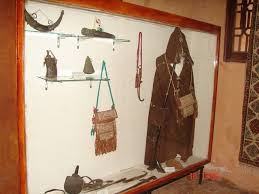Opened in
1985, this museum covers an area of 300 m2 and occupies the left area of the
Kasbah, the splendid monument of the city of Chefchaouen.
Historical Overview of the building
The museum occupies
a large space in the northwest part of Kasba. Originally, it was the private
residence of Prince Moulay Rachid Ben Ali, the founder of the city of
Chefchaouen in 1471.
in 1743, During
the reign of Sultan Moulay Ismail, the building was restored by one of its
governors, the commander Ahmed Ben Ali Rifi, which made the Kasba prestige and
role of yesteryear: the regional command center of Chefchaouen and the tribe of
Ghmara.
The
building of the museum was occupied and used as a community center by the
Spaniards during the protectorate.
Place of memory, history museum
At least we
can say about this space that strengthens and preserves the cultural identity
of the region. This identity held by the exhibits takes you far into the past
of the region to make you relive slices of history full of life and you portray
an almost gross regional cultural legacy.
Collection of works on display
Specific
traditional clothes to the inhabitants of four major tribes of the region:
Lakhmas, Ghzawa, Bani Msara and Rhouna .
Silver jewelry that chefchaouen Jews excel in
their manufacture.
Weaving
items such as Mendil, Belt (Hzam) Haik ...
The various
embroidery types in different geometric patterns on pillows and worn belts
women.
Traditional
firearms and accessories such as rifle called (Khmassiya) of powder horns,
daggers, swords ... These pieces date from the time of the resistance against
the Spanish colonization.
Rif’s
pottery tableware manufactured locally characterized by the simplicity of its
decoration with floral motifs. This dish exempts from any complexity such as
polychrome and varnish that characterize the city of ceramic Safi, Fes and
Meknes.
The different
musical instruments that relate to two kinds of music: the music andoulouse,
that of the elite, and popular music specific to the region "taktouka
Jabaliya." This kind of music was based on typical instruments such as the
stringed instrument Oud, guembri Kamane, rbab. The instruments for the rhythm:
the drum, Def, the small drum and taarija. Air instruments: flute, Rayta ...
A
collection of coins from the time of Alawites, discovered in the area at the
bottom of a pitcher during the 19th century, during the reign of Sultan Moulay
Alaoui Abderrahman Bnou Hicham (1822-1859).
Wooden
objects decorated with colors that reflect the local environment. Forest
resources, such as oak and cedar, enabled people a diversified use of
instruments and wooden tools. Among all the wooden masterpieces exhibited in
the museum, the coffers of "choir" for the conservation of the bride
goods. These chests, large, medium or small, decorated or not, reflected the social
class at which the bride belonged. Beside these wooden items, you can find also
the front door of the residence of Moulay Rachid Ben Ali included in the museum.
Copper
utensils, such as plates, cups and other objects of various geometric and shapes.




